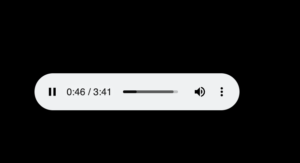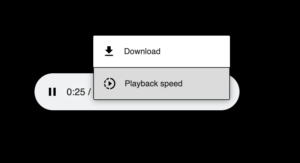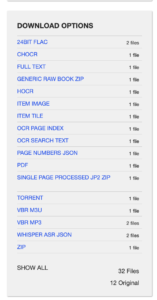The goal of these projects is to learn how to create parts of a podcast or a full 3 minute or more podcast by going through the exercises.
Exercises 20 points
Use any audio file for 5.1 – 5.2; Use an older (1920s era) file with clicks and pops for 5.3
5.1a – File management – Open your mp3 and save the file as an audacity project. Export to m4a (ACC), mp3 and wav formats. (Intro to Audacity Editing)
Web location –– Upload to audio.com (free account) or soundcloud.com (also free account but limited). Once the audio file is uploaded, open your WordPress.com page and look for the “Add Media” function. You have to click on the little black box with the white cross. You may see Soundcloud or YouTube in the “Add Media” box, but not Audio.com (yet). If you dont see them in the small window, click through to a larger window or search for them. No copy and paste the URL from your Soundcloud or YouTube page into the Add Media dialogue box.
5.1b – Basic editing — Select a 30 second portion of the file to save and discard the rest. Then duck (reduce the volume) at the beginning and end of the file to allow a voice-over intro. Then add a voice track.
5.1c – Filtering — Remove clicks and pops in an old audio file (Such as this Dvorak Serenade in E Major)
See this Audacity Noise Reduction tutorial, and especially the section on removing clicks and pops. You can also try using the high shelf filter (new in Audacity 3..3).
5.1d – Effects – Download and open something short (for example, this clip from Dvorak’s New World Symphony.) Try the various sound effects, and then undo each in turn. One fascinating effect is the Effect / Pitch and Tempo / Paulstretch. It is named for Octavian Paul (more information here).
Post each of these exercises for 20 points.
5.2 Podcast Intro (20 points): Create a 15 second news program intro using your voice along with public domain sound effects and music. You’ll export the .mp3 or .m4a files, then upload to YouTube, Soundcloud or some other streaming server, then embed / display on your portfolio site.
5.3 Podcast Intro2 (20 points): Create a 30 second public service announcement (PSA) using your voice along with public domain sound effects and music. You’ll export the .mp3 or .m4a files, then upload to YouTube, Soundcloud or some other streaming server, then embed / display on your portfolio site.
5.4 Podcast full program (60 points): Create a 3 minute (or more) podcast on topics around the campus or the city. Interview other people (not just students) as part of the podcast.
Use Audacity (the free audio application) or Adobe Audition, or any other audio application you like. Audacity is easy to download and completely free to use. (The official Audacity tutorial is found here, but there are lots of video and web tutorials available through a search).
First, come up with a concept and write your announcement. This can be for a made-up company or non-profit. It can be funny or serious. Usually we speak at a rate of about 100 to 130 words per minute, so a 30 second commercial might have only 50 to 60 words at the most, while a news program introduction may have 15 to 30.
Once you have written and rehearsed your PSA, you are ready to record, add sound effects, edit and export the file.
Import public domain music
Millions of free public domain music recordings and sound effects are available at archive.org. Some may be downloaded and some are just for streaming.
You may need the Chrome browser to download a file. (Other browsers don’t work as well). Look for the mp3 or m4a files on the right side and click the download button. (Note, sometimes archive.org takes you to a player site, and you have to click on the three dots — the hamburger — to get the download option).
If you download an mp3, and try to import into Audacity, you may find that you need an add-on called an FFmpeg. It’s available free with a quick browser search (for example “ffmpeg Audacity Mac” or for example here: And it installs quickly.
Download one of your favorite old time public domain songs from the Internet Archive (archive.org)
When you find a selection you like, click on the MP3 option
 Open the MP3 window, click on the “hamburger” menu and download. (This works best in the Chrome browser).
Open the MP3 window, click on the “hamburger” menu and download. (This works best in the Chrome browser).
Once the file is downloaded to your desktop it can be opened or imported into Audacity or Audition and used for your project. 
Create a project
- Create a new project in Audacity (or Adobe Audition) project. These instructions are written for Audition but they can be applied to other audio workstations).
- When you open the first window, it looks blank project. This is misleading. So you have two choices:
- Record using your microphone — Tracks / Add New / Multitrack Session
- Import a file — File / Import / Audio
- Name and save your file. Example: lastname.firstname.RadioSpot.
- Check that the saved file path is correct. By default, it will save to Documents\Adobe\Audition\13.0 (or Documents\Audacity). But you might want it to save to your desktop, your hard drive or some other more easily accessible place.
- Select “None” for template. There is no harm in trying out different templates, but they may be more hassle than they’re worth at the moment.
- Set sample rate to “44100” (44.1khz) and Bit Depth to 24.
- A higher bit depth (dynamic range) will affect the quality more than the sample rate. Record at 44.1 khz to keep file size manageable, and to integrate smoothly with many files downloaded from Freesound and other websites.
- Set Master to Stereo
More information and inspiration
- Starting your own podcast – National Public Radio

